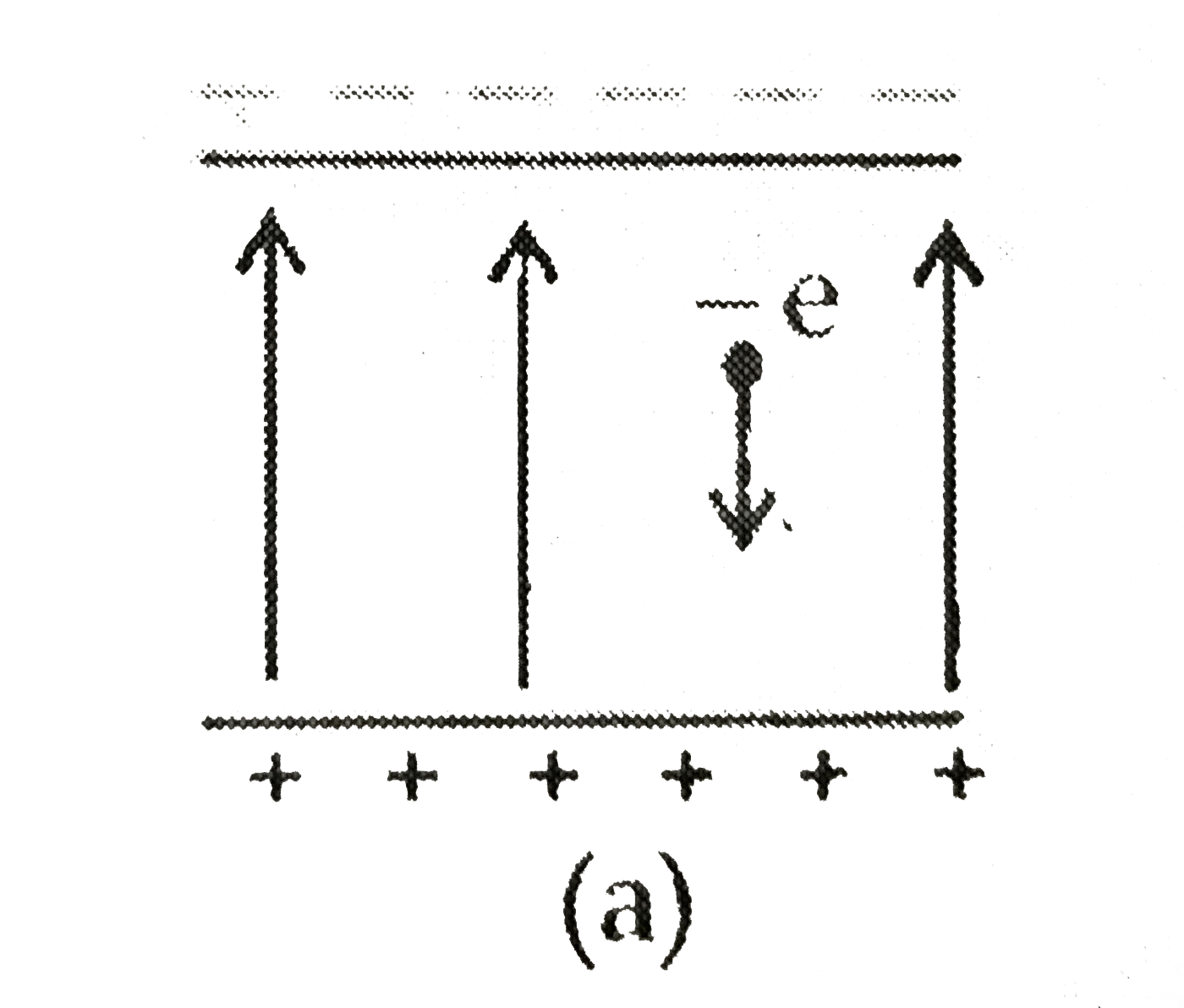An electron initially at rest falls a distance of 2 cm in a uniform electric field of magnitude 3×104NC−1. The time taken by the electron to fall to this distance is
1.3×102s
2.1×10−12s
1.6×10−10s
2.75×10−9s
The correct Answer is:D
To solve the problem of an electron falling a distance of 2 cm in a uniform electric field of magnitude 3×104N/C, we will follow these steps:
Step 1: Identify the forces acting on the electron
The force acting on the electron due to the electric field can be calculated using the formula:
F=qE
where q is the charge of the electron and E is the electric field strength.
Step 2: Calculate the force on the electron
The charge of an electron is approximately q=−1.6×10−19C. The magnitude of the electric field is given as E=3×104N/C. Therefore, the magnitude of the force is:
F=|q|E=(1.6×10−19C)(3×104N/C)=4.8×10−15N
Step 3: Calculate the acceleration of the electron
Using Newton's second law, F=ma, we can find the acceleration a of the electron:
a=Fm
The mass of the electron is approximately m=9.1×10−31kg. Substituting the values:
a=4.8×10−15N9.1×10−31kg≈5.27×1015m/s2
Step 4: Use kinematic equations to find the time taken
We will use the kinematic equation:
S=ut+12at2
where S is the distance fallen, u is the initial velocity (which is 0 since the electron starts from rest), and a is the acceleration. Since u=0, the equation simplifies to:
S=12at2
Rearranging for t:
t=√2Sa
Step 5: Substitute the values
The distance S is given as 2cm, which we convert to meters:
S=0.02m
Now substituting the values:
t=√2×0.02m5.27×1015m/s2=√0.045.27×1015
Calculating this gives:
t≈√7.58×10−17≈2.75×10−9s
Final Answer
The time taken by the electron to fall a distance of 2 cm is approximately:
t≈2.75×10−9s
The force acting on the electron due to the electric field can be calculated using the formula:
F=qE
where q is the charge of the electron and E is the electric field strength.
The charge of an electron is approximately q=−1.6×10−19C. The magnitude of the electric field is given as E=3×104N/C. Therefore, the magnitude of the force is:
F=|q|E=(1.6×10−19C)(3×104N/C)=4.8×10−15N
Using Newton's second law, F=ma, we can find the acceleration a of the electron:
a=Fm
The mass of the electron is approximately m=9.1×10−31kg. Substituting the values:
a=4.8×10−15N9.1×10−31kg≈5.27×1015m/s2
We will use the kinematic equation:
S=ut+12at2
where S is the distance fallen, u is the initial velocity (which is 0 since the electron starts from rest), and a is the acceleration. Since u=0, the equation simplifies to:
S=12at2
Rearranging for t:
t=√2Sa
The distance S is given as 2cm, which we convert to meters:
S=0.02m
Now substituting the values:
t=√2×0.02m5.27×1015m/s2=√0.045.27×1015
Calculating this gives:
t≈√7.58×10−17≈2.75×10−9s
The time taken by the electron to fall a distance of 2 cm is approximately:
t≈2.75×10−9s
Topper's Solved these Questions
- BOOK - MTG GUIDECHAPTER - ELECTROSTATICSEXERCISE - NEET VITALS18videos
ELECTROSTATICS
- BOOK - MTG GUIDECHAPTER - ELECTROSTATICSEXERCISE - AIPMT/NEET (MCQ.s)34videos
ELECTROSTATICS
- BOOK - MTG GUIDECHAPTER - ELECTROSTATICSEXERCISE - NEET Cafe (Topicwise Practice Questions)169videos
ELECTROSTATICS
- BOOK - MTG GUIDECHAPTER - ELECTRONIC DEVICESEXERCISE - AIPMT/NEET (MCQs)42videos
ELECTRONIC DEVICES
- BOOK - MTG GUIDECHAPTER - MAGNETIC EFFECTS OF CURRENT AND MAGNETISMEXERCISE - AIPMT/NEET (MCQs)48videos
MAGNETIC EFFECTS OF CURRENT AND MAGNETISM
Similar Questions
An electron falls through a distance 1.5 cm in a uniform electric field of magnitude 2.0×104NC−1 .Calculate the time it takes to fall through this distance starting from rest. If the direction of the field is reversed keeping its magnitude uncharged , calculate the time taken by a proton to fall through this distance starting from rest.
View SolutionAn electron falls through a distance of 1.5 cm in a uniform electric field of magnitude 2.0×104N/C(Fig.a)

Calculate the time it takes to fall through this distance starting from rest. If the direction of the field is reversed (fig .b) keeping its magnitude unchanged, calculate the time taken by a proton to fall through this distance starting from rest.
 View Solution
View Solution
Knowledge Check
- Question 1 - Select One
An electron initially at rest falls a distance of 1.5 cm in a uniform electric field of magnitude 2×104N/C. The time taken by the electron to fall this distance is
A1.3×102sB2.1×10−2sC1.6×10−10sD2.9×10−9s - Question 2 - Select One
An electron falls through a small distance in a uniform electric field of magnitude 2×104NC−1. The direction of the field reversed keeping the magnitude unchanged and a proton falls through the same distance. The time of fall will be
ASame in both casesBMore in the case of electronCMore in the case of protonDIndependent of charge - Question 3 - Select One
An electron (q=1.6×10−19C) is moving at right angles to a uniform magnetic field of 3.534×10−5 T The time taken by the electron to complete a circular orbit is
A2μsB4μsC3μsD1μs
A proton falls dwon through a distance of 2 cm in a uniform electric field of magnitude 3.34×103NC−1. Determine (i) the acceleration of the electron (ii) the time taken by the proton to fall through the distance of 2 cm, and (iii) the direction of the electric field.
View SolutionAn electron falls through a distance of 1.5 cm in a uniform electric field of magnitude 2.4×104NC−1 [Fig.1.12 (a)]. The direction of the field is reversed keeping its magnitude unchagned and a proton falls through the same distance [Fig. 1.12 (b) ]. Complute the time of fall in each case. Contrast the situation (a) with that of free fall under gravity.
 View Solution
View SolutionAn electron falls through a distance of 1.5cm in a uniform electric field of value 2×104N/C, opposite to direction of fall. Compare the time of fall with 'free fall under gravity'.
View SolutionAn electron is released from rest in a uniform electric field of magnitude 2.00×104N/C . (a) Calculate the acceleration of the electron. (Ignore gravitational) (b) How much time does the electron take to reach 1.00 % of the speed of light ?
View SolutionAn electron moves a distance of 6.0 cm when accelerated from rest by an electric field of strength 2×10−4NC−1. Calculate the time of travel.
View Solution

